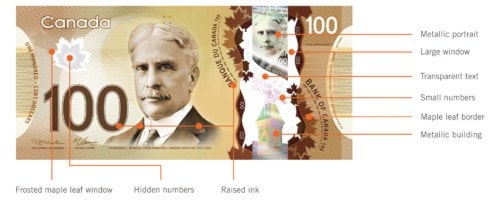Determining if a bill is counterfeit takes only a second, if you know what you're looking for.
So says Farid Salji, an analyst with the Bank of Canada, and he's showing people how.
Last year B.C. took the lead in the number of counterfeit Canadian bank notes passed – 37 per cent of approximately $2.6 million worth of fraudulent notes passed countrywide. Quebec took second place with 26 per cent.
"The Canucks couldn't do it, but unfortunately the counterfeiters did," said Salji.
Salji was in Nanaimo Wednesday to educate business owners on bank note verification and security features, what to do if they receive a suspected counterfeit note and to show people the new $100 polymer notes, which will be issued in November.
Counterfeit $100, $20 and $10 bills have circulated around the Island in recent months, including more than a dozen instances in Nanaimo since the beginning of June.
Salji said detecting these fraudulent notes can be done quickly and simply by holding the bill at chest level and tilting it toward you or holding it up to light.
Three security features will become visible on a real bill – a ghost image in a blank space near the centre of the bill, a solid line running through the denomination of the bill on the right side of the front of the bill, and a number puzzle beside the ghost image, which appears as a series of irregular marks when viewed straight on, but becomes a number when tilted or held up to the light.
No counterfeit note will have all three of these features, said Salji.
He also cautions people against other modes of verification – raised ink wears over time, some fraudulent notes mimic the ultraviolet feature to the point where people are fooled when viewing the bills under a black light, and both real and fake bills can leave an ink smear when rubbed on a piece of paper.
If you come across a suspect note, give the bill back to the person offering it, ask for a different form of payment, advise the person to check the note with police, then call the police and inform them about a possible attempt to pass counterfeit money, said Salji.
"You don't have to accept it, but at the same time don't put yourself in a volatile situation," added Const. Gary O'Brien, Nanaimo RCMP spokesman.
Try to remember what the person looks like and any other details to pass on to police, he said.
Since June 1, police have recorded 15 instances of counterfeit bills in Nanaimo.
O'Brien said most of the occurrences are at independent, standalone locations where a person can more easily escape if the fraud is detected.
He recommends people educate their employees on what to look for and not allow themselves to be bullied into accepting a suspicious note.
New bank notes printed on polymer and with enhanced security features are on the way, said Salji.
A new $100 will be issued in November, a $50 note next spring and the $5 and $10 bills will follow in 2013.
The primary reason is to stay ahead of counterfeiting, but the notes are also more durable – the Bank of Canada estimates they will last two and a half times longer.
The new bills feature raised ink, a large transparent window and metallic images. The bills are easy to verify and difficult for counterfeiters to simulate.
For more information on the new bank notes and their security features, please visit www.bankofcanada.ca/banknotes.
u 90--per cent decrease in number of counterfeit bills passed in Canada between 2004 and 2010; from $13 million to $2.6 million
u 90--per cent of all counterfeit bills in 2007 were $5, $10 and $20 notes
u 37--counterfeit notes are passed in Canada for every million genuine notes
u 47--per cent of counterfeit notes passed in 2010 were $20 bills and 35 per cent were $100 bills
